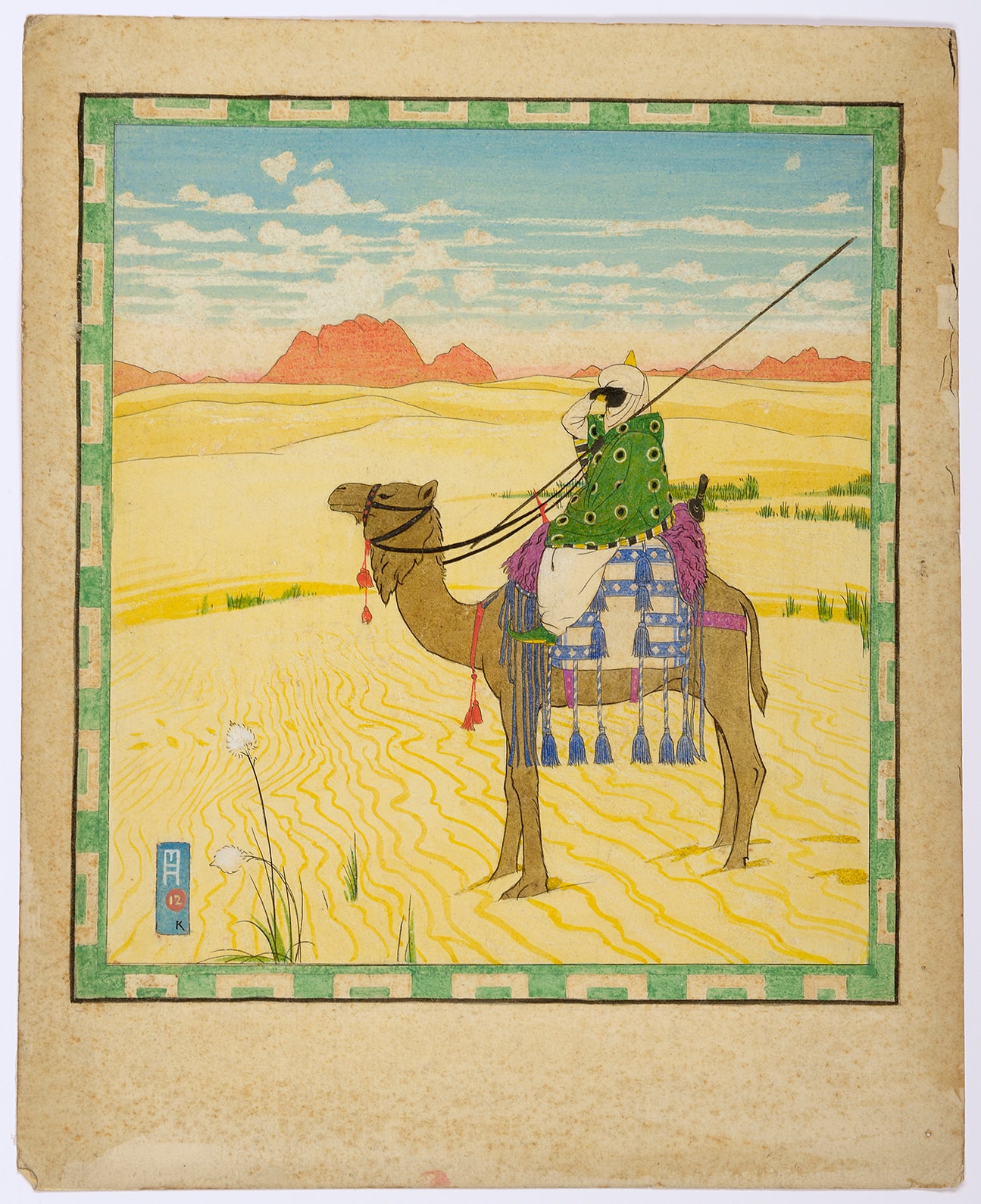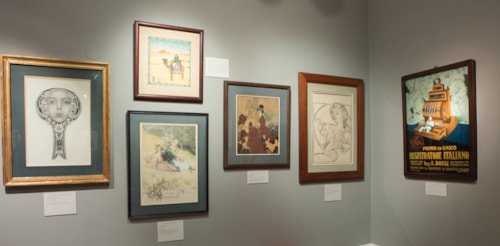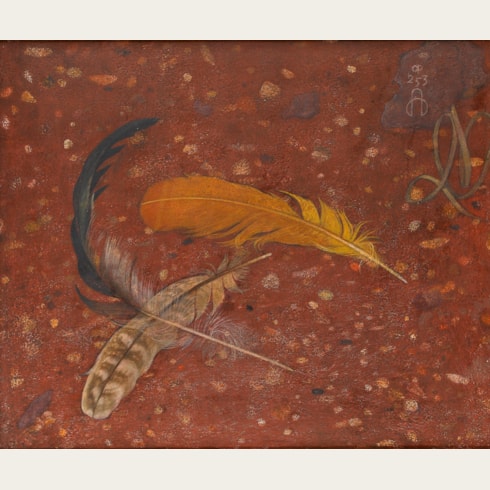Maxwell ARMFIELD
(Ringwood 1881 - Dorset 1972)
‘How the Camel Unbent’: Study for The Armfields’ Animal-Book
Sold
Watercolour over pen and grey ink, within a fictive border of a green and white pattern, and framing lines in brown ink.
Signed and dated with the artist’s device and monogram MA 12 K at the lower left.
Inscribed (by Sewell) 'Unpublished ill. to How the Camel Unbent, Chapter 4 of / TheArmfield’s Animal Book, p.43, 1922. / Published ill. is pink sky with five stars + crescent moon, horizon level with / camel’s knees, and [?] border: rider has green cloak with black circles in / white rings.' on the old mount.
225 x 206 mm. (8 7/8 x 8 1/8 in.) [image]
290 x 235 mm. (11 3/8 x 9 1/4 in.) [sheet]
Signed and dated with the artist’s device and monogram MA 12 K at the lower left.
Inscribed (by Sewell) 'Unpublished ill. to How the Camel Unbent, Chapter 4 of / TheArmfield’s Animal Book, p.43, 1922. / Published ill. is pink sky with five stars + crescent moon, horizon level with / camel’s knees, and [?] border: rider has green cloak with black circles in / white rings.' on the old mount.
225 x 206 mm. (8 7/8 x 8 1/8 in.) [image]
290 x 235 mm. (11 3/8 x 9 1/4 in.) [sheet]
Armfield worked in collaboration on many of his book illustrations, most notably with his wife, the writer and artist Constance Smedley (1876-1941), whom he married in 1909. The duo worked in tandem on several projects, including such books as The Flower Book, Sylvia’s Travels, Wonder Tales of the World and The Armfields’ Animal-Book. The present sheet is a study for an illustration accompanying the short story ‘How the Camel Unbent’, included in The Armfields’ Animal-Book, authored by Constance Smedley Armfield and illustrated with eight colour illustrations by Maxwell Armfield. The book was published in 1922.
The story concerns a ‘most patrician Camel’ belonging to one of the three Wise Men, who led a life of pampered luxury. Honoured by being chosen for a journey to the palace of Herod, King of Judea, the haughty camel looks down his nose on his surroundings and everyone in them, only to be treated in no manner of respect upon arriving in Jerusalem. Following the new, bright star in the sky, the Wise Men guide the camel and his companions to Bethlehem, where the camel is struck by the dignity with which other animals bear their misfortune and responsibilities. As the camel reflects: ‘These thin and weary asses did not endure disdainfully, nor set stimulating examples to each other, nor bear their lot with patrician fortitude: they suffered and endured as everyone was suffering and enduing, making no complaint and grateful for the least of mercies.’On leaving Bethlehem and the manger, bathed in the divine light of the star, the once-patrician camel is humbled and has found his peace.
The story concerns a ‘most patrician Camel’ belonging to one of the three Wise Men, who led a life of pampered luxury. Honoured by being chosen for a journey to the palace of Herod, King of Judea, the haughty camel looks down his nose on his surroundings and everyone in them, only to be treated in no manner of respect upon arriving in Jerusalem. Following the new, bright star in the sky, the Wise Men guide the camel and his companions to Bethlehem, where the camel is struck by the dignity with which other animals bear their misfortune and responsibilities. As the camel reflects: ‘These thin and weary asses did not endure disdainfully, nor set stimulating examples to each other, nor bear their lot with patrician fortitude: they suffered and endured as everyone was suffering and enduing, making no complaint and grateful for the least of mercies.’On leaving Bethlehem and the manger, bathed in the divine light of the star, the once-patrician camel is humbled and has found his peace.
Although he studied at the Birmingham School of Art, Maxwell Ashby Armfield was largely self-taught as an artist. Under the influence of Joseph Southall, he began experimenting with painting in tempera, although he only began taking up the medium with more seriousness around 1910. In 1902 Armfield settled in Paris, where one of his small paintings was acquired by the State for the Musée de Luxembourg. His first significant one-man exhibition was held at the Carfax Gallery in London in 1908, and a review in The Times noted the artist as ‘a man of originality and promise…[he] is said to be very young: but he is also very versatile…his gifts are undoubted.’ This exhibition was followed two years later by a show at the Leicester Galleries in London, and other gallery exhibitions elsewhere. Armfield showed at the Royal Academy, the New English Art Club and the Royal Watercolour Society.
Armfield also exhibited in America, where he lived for seven years between 1915 and 1922. An exhibition of twenty-one paintings, entitled America East to West, was held in London soon after his return, followed three years later by Armfield’s account of his travels, published as An Artist in America. A prolific and accomplished illustrator and decorative artist, he also found the time to publish a number of books of poetry, travel accounts and technical guides such as the Manual of Tempera Painting, published in 1930. Although his work was largely forgotten after the Second World War, Armfield lived to see a reassessment of his oeuvre take place in the 1970’s. Paintings by the artist are in the collections of the Tate, the Birmingham Museums and Art Gallery, the Southampton City Art Gallery, and elsewhere.
Provenance
Brian Sewell, London.
Literature
Constance Smedley Armfield, The Armfields’ Animal-Book. London, 1922, illustrated facing p.43.






